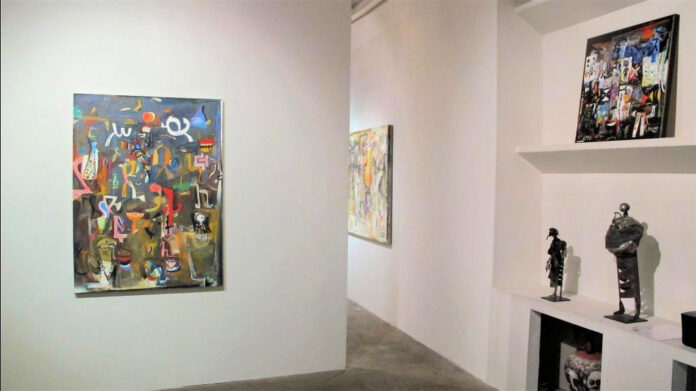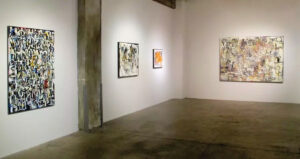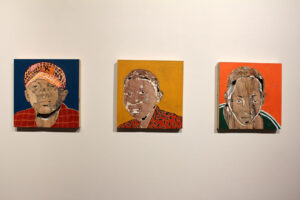
At first, you hardly realize that Skoto Gallery, nestled in Manhattan’s Chelsea art district, is a space of resistance against neocolonial oppression. But as you reacquaint yourself with the many well executed works presented on its walls over the years, the words “Exprimez-vous!” (Express yourself!) echo in your head. This was the peremptory command reminding you, even when away from your school bench, that you had to “express” yourself in the Master’s tongue. So, it now becomes evident to you through this conflation of art and language mastery that the gallery, which is celebrating its 30th anniversary, has been contesting Western dominance since its founding in SoHo back in 1992 through its re-presentations of the would-be universalist lingo of modernist art.
What are you to make of its preoccupations, rarefied and indulgent as they might be, vis-à-vis an eventual liberation from the Master’s control, you who have been lapping up for decades on still foreign soil as many new words and ideas as you could ingest?
You do recall some of the shows you’ve seen at the gallery over the years. For those you haven’t seen, you’ll simply fill in the blanks once you’ve delved into its edifying website. Although there are exceptions (South Korea and Peru, for instance), the artists shown at Skoto are mostly African-born, or hail from the African diaspora, including the United States, Europe, and the Caribbean. The predominant themes in their work are Nature, Self, and linguistic as well as socio-cultural and spiritual traditions, usually couched in modernist art styles. Aesthetically, by no means a homogeneous grouping, there are hardly among them card-carrying Duchampians, absolutist abstractionists, or irrational anarchists. Taking your cue from Jean-Jacques Dessalines’ long sidelined 1805 constitution, and simply for the purpose of this abbreviated and empowering exercise, you could say that all of the gallery’s contingent of artists, even Caucasians, are Black or African.

Indeed, Tout moun se moun! “Everyone [on Haitian soil] is a [black] person!” Encapsulated in such words, Dessalines’ relatively ultra-liberalist agenda seems pertinent.
“Exprimez-vous!”
Clearly, much of the art that Skoto has exhibited places due importance on formalist concerns — lines, color composition, etc. This is also evident in the press releases, without the gallery eliding its artists’ individual and socio-cultural motivations for making art. It has a soft spot for often color-rich and, especially, all-over abstract expressionist-like approaches to picture making. But a whole gamut of styles are exhibited, ranging from at times deliberately quirky (semi-) representational sculptures to forthrightly raw, lyrical, or kitschy works that often enough include readable or undecipherable texts and (photographic) images. In this ambience, one of the Master’s fancy phrases easily insinuates itself in your consciousness: “Oh, the pleasure of the text!”
Of course, contrary to how this phrase is often parroted, pleasure derived from processing a literary or visual text (from reader-spectator back to creator and vice-versa) is not a passively acquired skill and readily accessible sensation. It’s learned through study and exposure. You could acquire this rewarding ability right from the Master’s actual pronouncements or in the sanctum that are His great books, to the point where you can finish His sentences or convincingly formulate them yourself.
There’s a crucial problem, however. It’s the Master’s ears, or those of arbiters more or less formatted by Him, who can best decide your degree of fluency. For it’s axiomatic that you and the Master cannot occupy simultaneously the very same (types of) space, even if you were co-conspirators. Therefore, the two of you at least potentially must be of different worlds. Besides, there’s the obvious issue of deliberate, unequal opportunities to access the Master’s immediate domain. Consequently, perhaps your ability to express and indulge in your vaunted high art and in the “pleasure of the text” — or, analogously, in the all-important panache of some of Skoto’s artists’ execution of modernist mark making — stems from what you’ve partly experienced, half-heard, half-digested outside the Master’s window as you work in the field or even in His dining room, through the clatter of His utensils as He gabs and gorges himself. So, all along you’ve had to make do with simply filling in, joining and rejoining the unheard or imagined parts of His discourse.

Still, a more fundamental issue underlies the tension between the Master’s output and that of His would-be emulators. For you’ve always known on some level — and much more readily than He — that you are not, and never have been, a blank slate. Linguistically, culturally, something deep in you would always at least inflect or even counter the Master’s paradigm. Philosophically, everyone, including you and the Master, exists in a sort of invisible and quite malleable grid, so to say, that’s both objective and subjective and that regulates one’s undertaking in and disposition toward the world. Thus, all propositions, modernist or otherwise (except for those that are absolutist or anarchistic – for instance, color field painting, minimalism, dada or other deliberately illogical, un-relational approaches to art making), have their noticeable blind spots or weak links that stem from the cognitive and affective network that necessarily constitutes and regulates one’s existence. Therefore, the would-be objectivity (or subjectivity, if sought) of any discursive framework is compromised in some way. Consequently, the Master’s emulator often simply cannot with certainty choose for himself the reliable parts of the propositions he has to process. That’s the root of the discord in the Master-emulator relationship. Indeed, in reviewing the art of the pioneering Nigerian artist Uche Okeke at Skoto in 2015, a New York Times critic touches upon this “tension” when he states that the artist’s “modest-size” drawings would both “fit right in” and also, paradoxically, not altogether fit along with “Western work” of comparable size at the Museum of Modern Art. In other words, Okeke is arguably more than just a “modernist.” And fitting him into the framework of an even “larger Modernism” would still detract from his fullness.
Skoto’s roster of artists are generally well-educated, cosmopolitan, as well as socio-culturally conscious agents. By apprehending their visions through the filter of their own existence, a number of them have succeeded, in their particular aesthetic languages, in mastering what the Master Himself or His interlocutors have proclaimed to be His voice. Among this very large group of (semi-) abstractionists, one would have to include, among others, Nanette Carter, Peter Wayne Lewis, Myles Carter as well as Owusu-Ankomah, and Wosene Worke Kosrof who, with seven solo shows of exclusively text-based art, has been Skoto’s most exhibited artist.
But there are other artists who, though aware of the Master, opt to focus as if from the get-go on their own particular approaches to art making. They tend to eschew telegraphed eloquence, but the pared down, expressive qualities in their work seem at the same time all the more potent. For instance, if in his portraits Aimé Mpané seems metaphorically to carve out with his adze the supposed flesh and bones of the people he depicts, it’s perhaps to render their condition more nakedly apparent. And though by no means similar in their approaches, both George Afedzi Hughes, in his silently violent car crashes and ironically clashing images, as well as Osi Audu, in the tight interfacing of interior and exterior spaces in his highly reductive yet condensed drawings, resolutely stay their individual course, regardless of the (superficial) proximity of their approaches to modernist precedents.
Lastly, there is a third category of artists, perhaps as large if not larger than the more full-on (semi-) abstractionists, who seem deliberately to ignore the Master altogether. This last cohort of mavericks could be divided in two subgroups. One would comprise artists such as Donald Locke, Pefura and Katherine Taylor, all of whose works seem as idiosyncratic and personal as they are contemporary. Among them, at last, the tyranny of modernist eloquence, autonomy, and even originality are mostly shunned. But if you should miss from these three artists the more immediately rewarding visual pleasure to be derived from the works of those in the first two groups, you’d probably do quite well with Mor Faye, Afi Nayo and Fathi Hassan. Their art is bracingly captivating, gritty, and immediate. More importantly, it’s not just disinterested pleasure that you get from looking at their individual works. You’re shot in the arm with life at its richest.
So, in this context, is the Master’s voice now gone from your head? Most likely, it has just temporarily receded. Ultimately, it won’t do for Black liberation — itself, a learned process — to simply revise and modify the “histories of modernism” so as to show its “local particularities” and “global breadth.” Another New York Times critic had said as much upon seeing a show of early Latin American abstraction at the Grey Art Gallery and the exhibition “‘Haitian Masters’: 1950s-1980s” at the Edward Thorp Gallery. The works of Black artists should first be compared with and contextualized beside those of other Black artists, as opposed to measuring them against Euro-Americans. It’s the more ideal and practical way for Black art, or art by Black artists, to not just exist but thrive.
But it won’t be enough for you to be in a Black gallery space or on nurturing soil and in possession of a well-groomed artistic vocabulary that’s true to yourself and your roots. There also ought to be structural investments in the art you enjoy in order for the Master’s voice to become just one among your world’s multiple influences.
Skoto Gallery has been providing the framework for such investments for 30 years. To that accomplishment, it’s fitting to salute Skoto with a Haitian kreyòl word you sort of half-know — Savalouwe!
André Juste
New York, Jan. 28, 2022










[…] A past Exhibit at the Skoto Gallery, Photo Courtesy Haiti Liberte […]